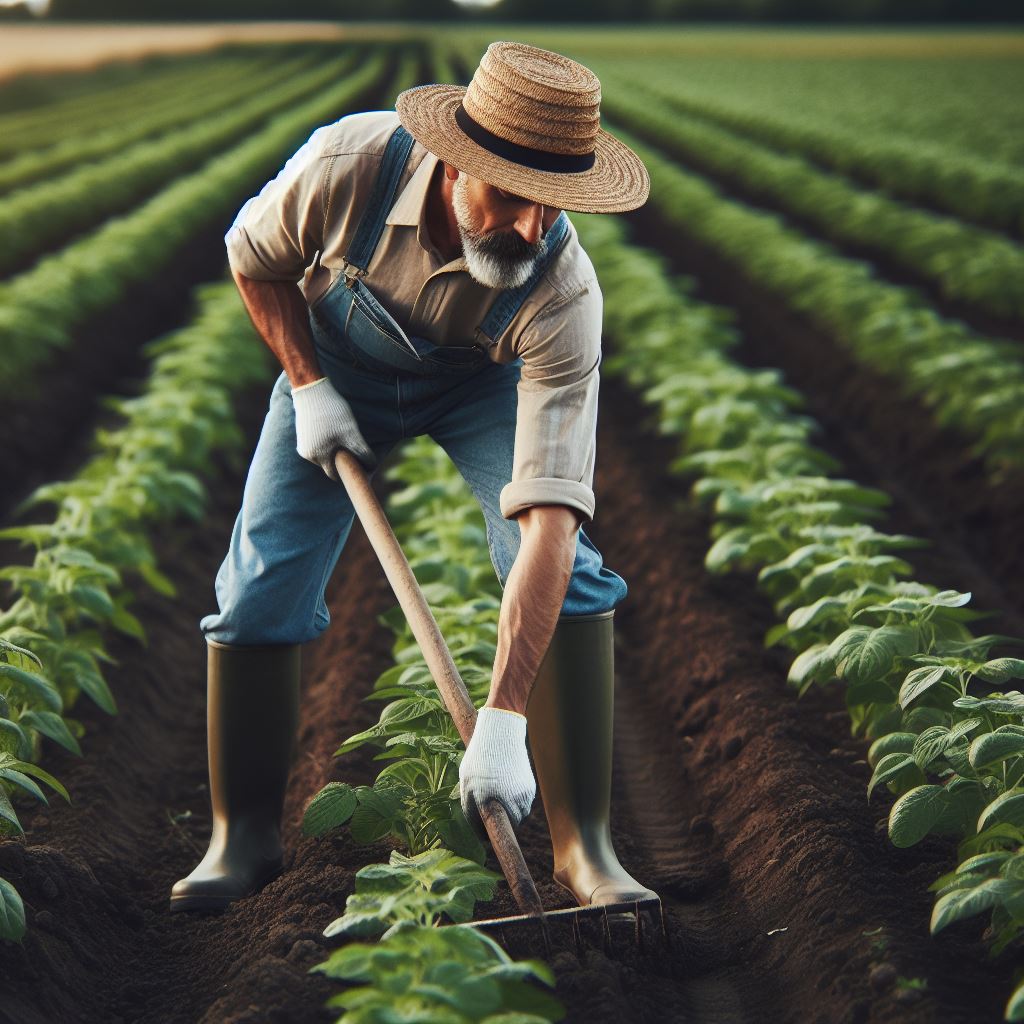Introduction
Drought-resistant farming is vital to combat water scarcity.
Explore effective strategies for cultivating resilient crops in challenging conditions.
Importance of Drought-Resistant Farming
- Water Scarcity Challenge: Addressing the global water scarcity challenge is crucial for sustainable agriculture.
- Crop Resilience: Drought-resistant farming ensures crops withstand water shortages, contributing to food security and economic stability.
- Environmental Impact: Mitigating the environmental impact of water-intensive farming practices is essential for preserving ecosystems.
Overview of the Topic
- Strategic Approaches: Discover proactive tips and tricks to optimize farming practices in regions prone to drought.
- Crop Selection: Explore suitable crop varieties equipped to thrive in arid conditions, ensuring a bountiful harvest.
- Water Conservation Techniques: Implement efficient irrigation methods, such as drip irrigation, mulching, and rainwater harvesting, to conserve water.
- Companion Planting: Learn about the symbiotic relationships between plants that enhance water conservation, like pairing shallow-rooted and deep-rooted plants.
- Soil Management: Understand the importance of well-aerated and healthy soil for water retention and runoff reduction.
- Crop Rotation Strategies: Implement crop rotation to break pest cycles, improve soil health, and manage water resources effectively.
Mastering drought-resistant farming techniques is pivotal for agricultural sustainability amid changing climates.
This section delves into practical tips and tricks to empower farmers facing water challenges.
Understanding Drought
Drought refers to a prolonged period of abnormally low rainfall, resulting in water shortages for agricultural purposes.
Causes and effects of drought
Drought can occur due to natural factors like climate variability, such as El Niño, or human activities like deforestation.
It leads to reduced crop yields, livestock deaths, and water scarcity.
Importance of dealing with drought in farming
- Economic impact: Drought can cripple agricultural production, leading to lower incomes for farmers and higher food prices for consumers.
- Food security: Drought affects food availability, leading to hunger and malnutrition in drought-affected regions.
- Environmental consequences: Drought contributes to soil erosion, desertification, and loss of biodiversity.
- Water management: Efficient water usage during droughts is crucial to conserve this scarce resource.
- Sustainable farming: Dealing with drought promotes sustainable agriculture practices that preserve soil health and water resources.
Mitigating Drought: Tips and Tricks for Drought-Resistant Farming
Crop selection
- Choose drought-tolerant crop varieties that can withstand water stress.
- Opt for native plants that are adapted to local drought conditions.
- Implement crop rotation to reduce water demand and enhance soil moisture retention.
Water conservation
- Install drip irrigation systems to directly deliver water to plant roots, minimizing evaporation.
- Collect and store rainwater in reservoirs or tanks during wet periods, ensuring a water supply during droughts.
- Mulch around plants to reduce soil moisture loss by preventing evaporation and weed growth.
Soil management
- Enhance soil organic matter by incorporating organic materials like compost or cover crops, improving water retention.
- Practice conservation tillage to minimize soil disturbance and conserve moisture.
- Implement contour plowing and terracing to prevent runoff and maximize water infiltration.
Efficient water management
- Monitor soil moisture levels regularly using moisture meters to ascertain irrigation needs accurately.
- Implement scheduling techniques like deficit irrigation, avoiding over-watering while meeting crop requirements.
- Employ precision farming technologies like remote sensing and irrigation sensors to optimize water use.
Integrated pest management
- Drought-stressed plants are more susceptible to pests and diseases. Implement holistic pest management strategies to minimize crop losses.
- Monitor and manage pests through biological control methods, such as attracting beneficial insects and using pheromone traps.
Agroforestry and windbreaks
- Planting trees and shrubs strategically can create windbreaks, reducing wind evaporation and soil moisture loss.
- Agroforestry systems provide shade, decreasing surface evaporation and conserving soil moisture.
Conservation practices
- Implement soil conservation practices like contour farming, strip cropping, or terracing to prevent soil erosion during drought.
- Use cover crops to protect the soil from direct sunlight and reduce evaporation.
Climate-smart agriculture
- Embrace climate-smart agriculture techniques that anticipate and adapt to climate change, including drought.
- Employ innovative technologies like precision farming, hydroponics, or greenhouse farming to mitigate drought risks.
By understanding drought, its causes, effects, and importance in farming, we can implement effective strategies to combat its impact.
Drought-resistant farming practices not only contribute to food security but also promote environmental sustainability and resilient farming systems.
Tips for Planning a Drought-Resistant Farm
Crop Selection: Choosing drought-resistant crops
One of the key strategies for planning a drought-resistant farm is selecting crops that are naturally resilient to dry conditions.
These crops have evolved to survive and thrive in low moisture environments, making them perfect for areas prone to drought.
When deciding on which crops to plant, farmers should consider factors such as heat tolerance, water requirements, and resistance to pests and diseases.
Some common drought-resistant crops include millets, sorghum, and legumes like cowpeas and lentils.
Soil Preparation: Improving water retention
Preparing the soil before planting is crucial in maximizing water retention and ensuring the long-term health of the crops.
Farmers should focus on improving the soil’s ability to retain moisture by incorporating organic matter, such as compost or manure, into the soil.
This will help create a more sponge-like structure that can hold water for longer periods.
Additionally, using mulching techniques, such as covering the soil with organic materials like straw or wood chips, can help reduce evaporation and keep the soil moist.
Irrigation Systems: Maximizing water efficiency
Effective irrigation systems are essential for drought-resistant farming.
Farmers should invest in water-efficient irrigation methods that minimize water waste and provide crops with the necessary moisture during dry periods.
Drip irrigation, for example, delivers water directly to the root zone of plants, reducing evaporation and allowing for precise water application.
Another option is using sprinkler systems with low-flow nozzles, which also help conserve water by targeting specific areas.
Conservation Practices: Protecting soil moisture
Implementing conservation practices can play a significant role in protecting soil moisture and preventing water loss on a drought-resistant farm.
One important technique is maintaining ground cover by growing cover crops or leaving crop residues on the soil surface.
This helps reduce water evaporation, improves soil structure, and enhances moisture retention.
Implementing contour tilling or terracing can also help to control water runoff and maintain moisture levels in the soil.
By combining these tips, farmers can develop a comprehensive plan for a drought-resistant farm.
Through careful crop selection, soil preparation, efficient irrigation systems, and conservation practices, farmers can mitigate the effects of drought and ensure the success of their farming operations.
Planning and implementing these strategies require proactive thinking and a commitment to sustainable practices, but the long-term benefits are well worth the effort.
Ultimately, a drought-resistant farm not only protects crops from the adverse effects of water scarcity but also contributes to overall environmental sustainability.
By utilizing these tips and tricks, farmers can minimize water usage, reduce reliance on irrigation, and conserve precious resources for future generations.
In the face of climate change and increasing water scarcity, drought-resistant farming practices are becoming more important than ever.
Read: Pest Control in Corn Fields: Effective Strategies
Techniques for Water Conservation
Drought-resistant farming demands smart water conservation.
Implement these techniques for efficient water use:
Mulching: Reducing Evaporation
Mulching is a powerful ally in the battle against water loss through evaporation.
By covering the soil with a layer of organic material—be it straw, bark, or compost—you create a protective barrier.
This not only shields the soil from direct sun exposure but also locks in moisture.
This simple yet effective method significantly reduces water evaporation, promoting optimal soil hydration for your crops.
Rainwater Harvesting: Collecting and Using Rainfall
Harnessing the power of nature, rainwater harvesting is a game-changer for water conservation.
Install rain barrels or cisterns to capture rainfall from rooftops.
This harvested water serves as a valuable resource for irrigation purposes.
By tapping into this eco-friendly method, you not only reduce dependence on freshwater sources but also contribute to sustainable farming practices.
Transform Your Agribusiness
Unlock your farm's potential with expert advice tailored to your needs. Get actionable steps that drive real results.
Get StartedDrip Irrigation: Targeted Water Delivery
Traditional irrigation often results in water wastage through runoff and evaporation.
Enter drip irrigation—a precise and efficient method.
This system delivers water directly to the roots of plants, ensuring they receive the exact amount needed.
By minimizing water loss, drip irrigation promotes optimal plant growth while conserving this precious resource.
Companion Planting: Beneficial Plant Combinations
Nature has its own way of conserving water through companion planting.
Certain plant combinations form symbiotic relationships, benefiting each other.
For instance, pairing shallow-rooted plants with deep-rooted ones creates a balance that helps retain moisture in the soil by reducing evaporation.
Explore the power of plant partnerships to enhance water retention and promote a thriving, water-efficient ecosystem on your farm.
In summary, incorporating these techniques into your farming practices not only addresses the challenges posed by water scarcity but also lays the foundation for sustainable and resilient agriculture.
Mulching, rainwater harvesting, drip irrigation, and companion planting are integral components of drought-resistant farming.
By actively embracing these methods, you not only contribute to the conservation of water resources but also foster a more robust and sustainable farming environment.
As you embark on this journey, remember that every drop saved today secures a more resilient tomorrow for your farm and the planet.
Read: Tomato Cultivation: Tips for a Healthy Crop

Soil Health and Drought-Resistance
Importance of soil health in combating drought
Soil health plays a crucial role in combating drought and ensuring the success of drought-resistant farming.
By adopting practices that promote soil health, farmers can optimize their yields even in water-deficient conditions.
Cover cropping: Building organic matter
One effective way to enhance soil health is through cover cropping.
This practice involves planting specific crops, such as legumes or grasses, during periods when main cash crops are not growing.
Cover crops help build organic matter in the soil, which improves its water-holding capacity and reduces erosion during droughts.
Composting: Improving soil structure and moisture retention
Composting is another valuable technique for improving soil structure and moisture retention.
By applying compost to the soil, farmers can increase its organic matter content, which improves the soil’s ability to retain water.
Compost also enhances the soil structure, allowing it to better absorb and hold moisture, reducing the impact of drought.
Crop rotation: Reducing water stress on specific plants
Crop rotation strategically reduces water stress, improving soil health by alternating crops and minimizing nutrient depletion and water resources.
This practice breaks pest cycles, reduces weed pressure, and maintains soil fertility for effective drought resistance.
Regular soil testing is essential for monitoring nutrient levels and pH balance, allowing informed decisions on fertilization and amendments.
Applying mulch to the soil surface acts as a protective layer, reducing evaporation, controlling weed growth, and conserving water.
Conservation tillage promotes soil health by minimizing traditional plowing, preserving soil structure, and preventing moisture loss during droughts.
Efficient irrigation management, using systems like drip irrigation, minimizes water waste by providing water directly to plant roots.
Rainwater harvesting captures and stores rainfall, reducing dependence on external water sources during dry periods.
Moisture sensors and weather-based irrigation controllers prevent over-irrigation, conserving water resources and optimizing water use.
In general, implementing active practices like crop rotation, soil testing, mulching, conservation tillage, and efficient irrigation fosters sustainable drought-resistant farming.
Read: Best Soil Types for Growing Wheat: An Overview
Explore Further: Balancing Soil Nutrients for Crops
Monitoring and Managing Drought
Monitoring and managing drought on your farm is crucial to ensure the success of your crops and livestock.
By implementing various strategies, you can effectively track and respond to drought conditions, efficiently utilize irrigation water, identify drought stress in plants, and have contingency plans in place for extreme drought situations.
Weather Monitoring: Tracking Drought Conditions
Regularly monitoring weather conditions is essential for identifying drought patterns and predicting their impact on your farm.
Use online resources and weather apps to keep track of precipitation levels, temperature, and humidity.
Keep an eye on drought indices such as the Palmer Drought Severity Index (PDSI), Standardized Precipitation Index (SPI), and the U.S.
Drought Monitor. These tools provide valuable insights into the severity and duration of drought in your area.
Water Monitoring: Efficient Use of Irrigation Water
During drought, it is crucial to optimize the use of irrigation water to minimize waste and maximize plant productivity.
Implement water-saving techniques such as drip irrigation and micro-sprinklers, which deliver water directly to the root zone of plants, reducing evaporation and runoff.
Regularly inspect irrigation systems for leaks and malfunctions and promptly repair them to avoid water loss.
Showcase Your Farming Business
Publish your professional farming services profile on our blog for a one-time fee of $200 and reach a dedicated audience of farmers and agribusiness owners.
Publish Your ProfileConsider using soil moisture sensors or tensiometers to monitor soil moisture levels.
This data can help you determine when and how much water to apply, ensuring efficient irrigation practices.
Early Warning Systems: Identifying Drought Stress in Plants
Monitoring the health and vigor of your crops and plants is crucial for early detection of drought stress.
Regularly inspect your plants for visible signs of drought stress, such as wilting, leaf rolling, and yellowing.
Use plant-based monitoring techniques like measuring leaf stomatal conductance or leaf water potential to assess plant water status.
Consider using remote sensing technologies, such as thermal imaging or normalized difference vegetation index (NDVI) analysis, to detect patterns of drought stress across large areas of your farm.
Emergency Preparedness: Contingency Plans for Extreme Drought
Preparing for extreme drought conditions involves having proactive contingency plans in place to mitigate the impact on your farm’s productivity.
Diversify your crops and livestock to reduce dependence on water-intensive varieties or breeds.
Implement soil conservation practices, such as cover cropping and mulching, to improve the soil’s water-holding capacity and reduce evaporation.
Develop a water management plan that includes water allocation priorities, alternative water sources, and water rationing measures.
Stay informed about government assistance programs and insurance options that can provide financial support during drought emergencies.
Regularly review and update your emergency preparedness plans to adapt to changing drought conditions.
By monitoring weather and water conditions, detecting drought stress in plants, and having contingency plans, you can effectively manage and respond to drought situations on your farm.
Implement these tips and tricks to ensure the resilience and success of your farming operations.
Read: Climate Impact on Potato Growth: What to Know
Case Studies: Successful Drought-Resistant Farming Practices
In this section, we will explore case studies of farms that have successfully implemented drought-resistant techniques.
By examining their strategies and results, we can learn valuable lessons and key takeaways for our own farming practices.
Green Acres Farm
- By implementing a drip irrigation system, Green Acres Farm reduced water usage by 50%.
- The farm also focused on soil management, using organic matter and cover crops to retain moisture.
- As a result, crop yields increased by 20% even during drought periods.
Sunny Meadows Ranch
- Sunny Meadows Ranch implemented agroforestry practices such as planting trees to provide shade and reduce evaporation rates.
- They also employed precision irrigation systems and monitored soil moisture regularly.
- These efforts led to a 30% reduction in water usage and improved animal grazing conditions.
Harvest Haven Gardens
- Harvest Haven Gardens employed mulching techniques to conserve soil moisture and suppress weed growth.
- They also practiced crop rotation to avoid depleting specific nutrients in the soil.
- As a result, the farm experienced minimal crop loss during droughts and maintained steady yields.
Lessons learned from these case studies
- Implement efficient irrigation systems: Drip irrigation and precision irrigation can significantly reduce water usage while maintaining crop yields.
- Focus on soil management: Improving soil health through organic matter and cover crops helps retain moisture and enhance soil resilience to drought.
- Utilize agroforestry practices: Planting trees strategically can provide shade, reduce water loss, and create a more sustainable farming ecosystem.
- Practice mulching and crop rotation: Mulching conserves soil moisture and reduces weed competition, while crop rotation prevents soil nutrient depletion.
- Monitor and manage soil moisture: Regularly monitoring soil moisture levels allows farmers to adjust irrigation practices accordingly and avoid overwatering.
- Invest in research and innovation: Staying informed about new technologies and techniques is crucial to adapt and develop innovative solutions for drought-resistant farming.
Key takeaways
- Successful drought-resistant farming involves a holistic approach that combines various techniques tailored to the specific farm and region.
- Water conservation and soil management should be at the core of every drought-resistant farming strategy.
- Diversifying farming practices, such as integrating livestock or planting trees, can enhance resilience to drought and provide additional income streams.
- Sustainable farming practices not only mitigate the impact of drought but also contribute to long-term environmental and economic sustainability.
By studying these case studies and embracing the lessons they offer, farmers can improve their own drought-resistant farming techniques.
With a proactive approach and the right strategies in place, it is possible to mitigate the devastating effects of drought on agriculture and ensure a more sustainable future.
Conclusion
The adoption of drought-resistant practices in farming is of utmost importance.
By implementing these methods, farmers can mitigate the impact of drought and ensure the sustainability of their operations.
In this section, we have discussed several key tips and tricks for drought-resistant farming.
These include selecting drought-tolerant crop varieties, improving soil health, using efficient irrigation techniques, and implementing mulching and cover cropping.
It is crucial for farmers to understand the significance of these practices and start implementing them.
Droughts can have devastating effects on agriculture, leading to decreased yields, financial losses, and even food insecurity.
By adopting drought-resistant farming methods, farmers can minimize these risks and maintain a stable production system.
We encourage all farmers to take action and prioritize drought-resistant techniques.
Start by assessing your farming practices and identifying areas where improvements can be made.
Implement the tips and tricks discussed in this section gradually, allowing for adjustment and learning from experience.
Remember, resilient farming is possible even in the face of drought.
By taking proactive measures, you can protect your livelihood, contribute to environmental sustainability, and ensure food security for current and future generations.




